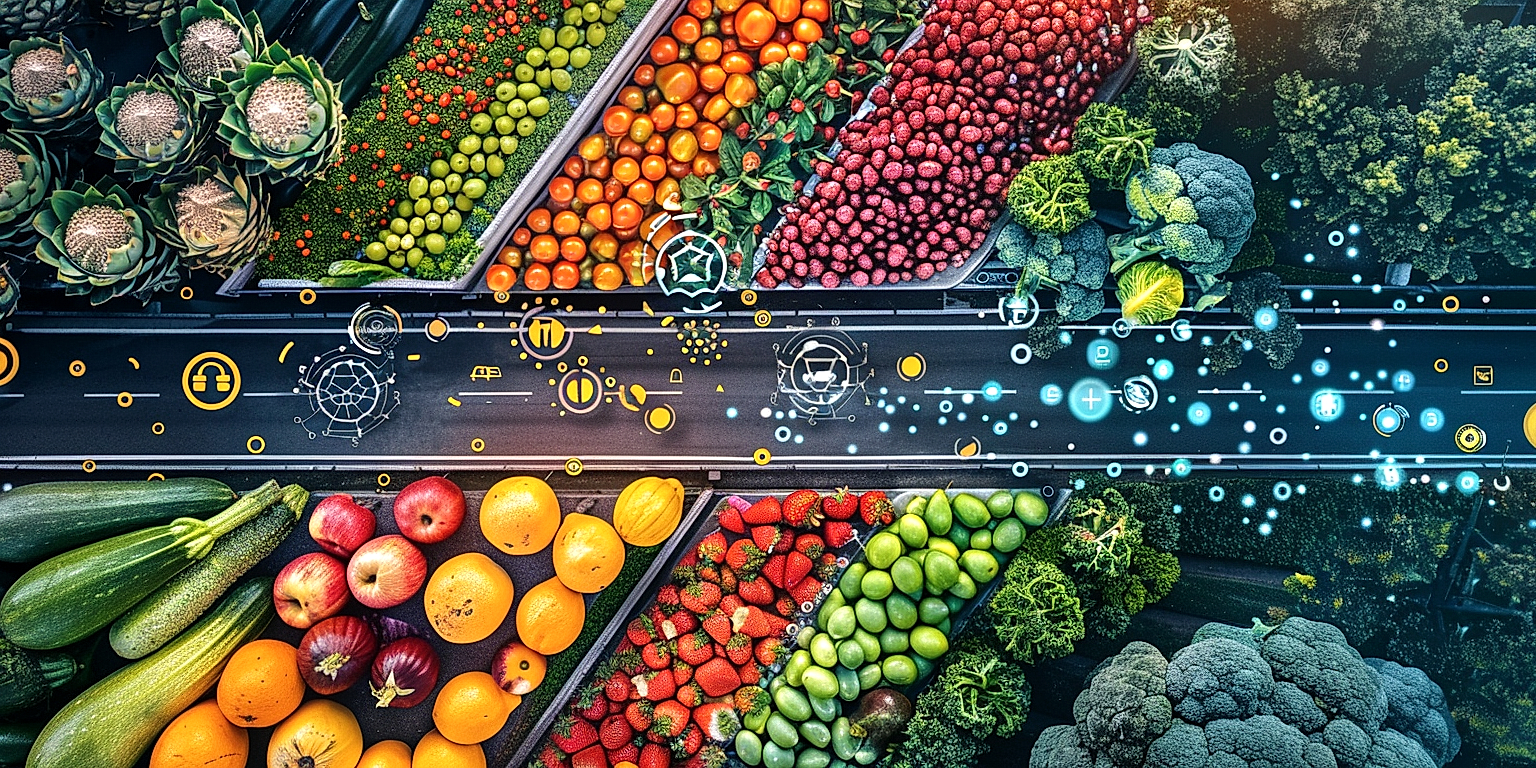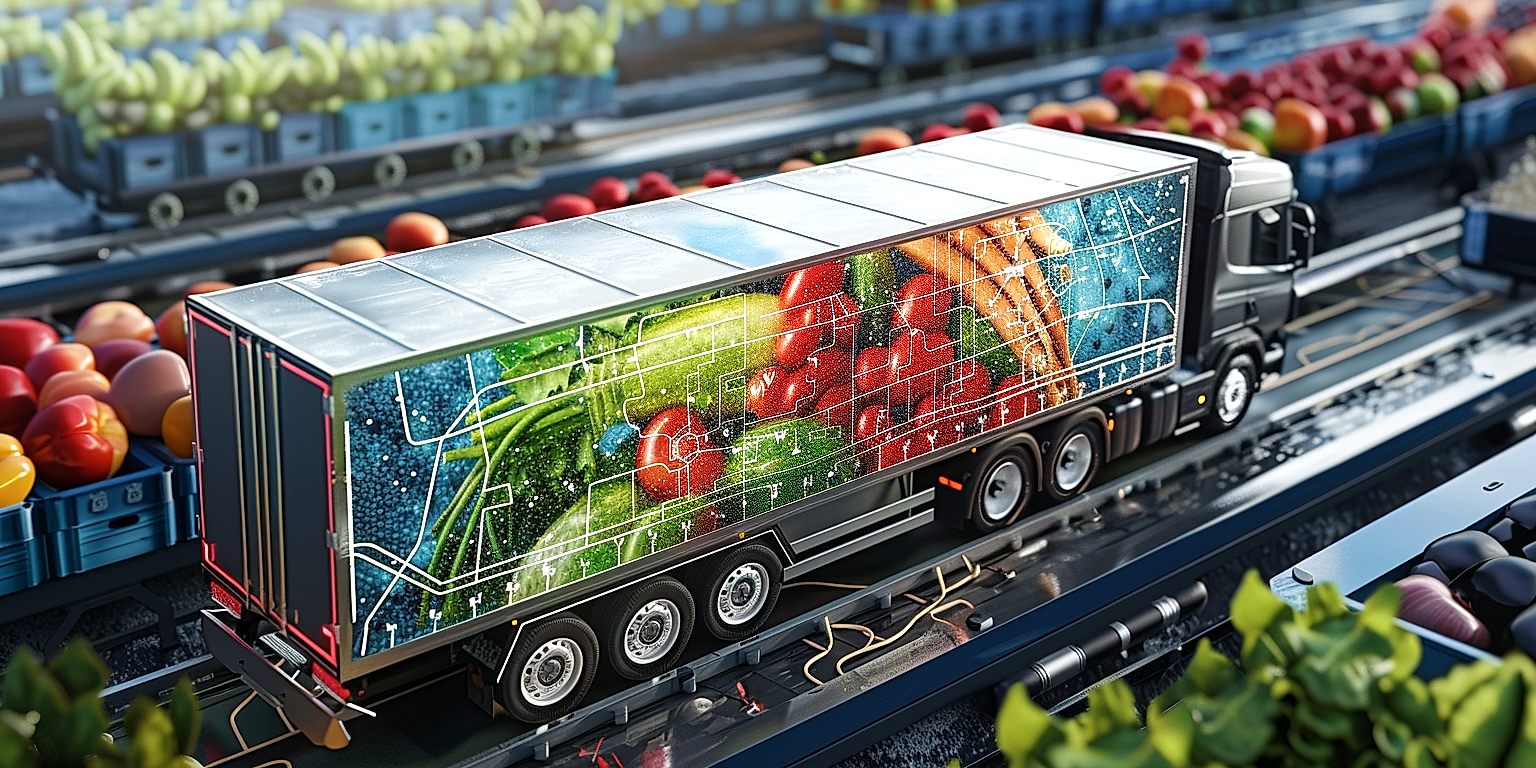Advancements in technology are consistently altering the landscape across various sectors, including the crucial area of produce shipping.
Efficient route planning stands at the center of this transformation, promising significant enhancements in the movement of perishable goods.
By leveraging the capabilities of cutting-edge systems, industry players can now optimize schedules, routes, and other key aspects of the shipping process.
The objective is to streamline operations, reduce costs, and ultimately ensure faster, fresher deliveries.
This discussion provides an insightful overview of these emerging technologies, exploring their innovative features, practical applications, and potential implications for the future of the produce shipping business.
The review identifies and delves into the leading solutions that are currently shaping this revolution in route planning.
Technologies Revolutionizing Route Planning In Produce Shipping
1. Autonomous and GPS Controlled Drones
Produce shipping has traditionally been a labor-intensive process, requiring precise manual route planning to ensure products arrive fresh and in excellent condition.
However, innovative technologies have started revolutionizing this industry, with autonomous and GPS controlled drones playing a pivotal role.
Drones, in this context, refer to Unmanned Aerial Vehicles (UAVs) fitted with GPS systems that allow for accurate navigation and prompt delivery of produce.
Their autonomous nature means they do not require constant human monitoring or manual operation, which greatly reduces errors caused by human fatigue or oversight.
At their core, these drones operate based on pre-programmed flight plans, which can be tailored to suit individual delivery routes, greatly enhancing route planning in produce shipping.
Indeed, the ability to easily alter and optimize a drone’s flight path makes them adaptable to various logistical challenges, such as sudden weather changes or road blocks.
The inherent flexibility ensures that produce is delivered efficiently, boosting overall productivity in the supply chain.
It’s also worth noting that GPS technology aids in real-time tracking of these drones, enabling immediate detection of any in-transit issues.
This enhances traceability and accountability in produce shipping, two factors that are critical in this sector due to the perishable nature of the goods.
Moreover, drones can reach places that are otherwise difficult to access, such as remote or rural areas, thereby expanding the accessible market size for a given produce supplier.
This allows for a more diversified customer base and can lead to greater profit margins for producers.
The reduced need for manual intervention in the route planning and delivery process also has the potential to greatly lower labor costs.
This cost-saving advantage is particularly significant in sectors where labor is a substantial portion of overall operational expenses.
Furthermore, drones can offer faster delivery times compared to conventional vehicles, as they can fly directly to their destination without the need to navigate traffic or stop at traffic lights.
Overall, the integration of autonomous and GPS controlled drones in produce shipping marks a huge stride in the digitization and automation of the industry.
It not only optimizes route planning but also increases efficiency, reduces costs, and enhances accountability through increased traceability.
2. Advanced predictive analytics software
In the context of produce shipping and route planning, the application of advanced predictive analytics software plays an integral role.
This innovative technology has brought revolutionary changes in making data-driven decisions, thereby optimizing the efficiency and reliability of the shipment process.
Primarily, predictive analytics software utilizes statistical algorithms and machine-learning techniques to analyze historical data and predict future outcomes.
In the realm of produce shipping, such software helps in accurately forecasting the time that will be required to deliver fresh produce from the farm to the retail store.
Moreover, it assists in predicting potential road circumstances that could affect the overall shipping time.
By considering elements like weather conditions, traffic density, road constructions, and more, it generates the most efficient routes for trucks to take.
This not only ensures on-time produce delivery but also contributes to managing the lifespan of perishable goods.
Predictive analytics software can thus curtail the cost caused by delays and product wastage during transit.
Another crucial function of this technology is its capacity to calculate the probability of future outcomes based on input data.
Pertaining to this, it can suggest alternative route plans when faced with unforeseen issues or sudden changes in schedules, drastically reducing uncertainty in planning.
Furthermore, predictive analytics has an immense capability to analyze a plethora of data points at unparalleled speed.
Considering the growing array of interconnected logistics data, this feature can be a significant driver for supply chain optimization.
For instance, it can process and analyze data from IoT devices installed in transport units to monitor temperature, humidity conditions in real-time which helps in maintaining the quality of perishable goods.
Thus, the integration of advanced predictive analytics into the planning process is facilitating an advanced level of precision and agility in logistics management, tipping the balance in favor of those who have adopted it.
As such, the strategic use of predictive analytics software holds a promising potential to reshape the landscape of route planning in produce shipping by increasing efficiency, reducing costs, and enhancing customer satisfaction.
3. Real-time traffic monitoring systems
Real-time traffic monitoring systems are playing a pivotal role in transforming route planning for produce shipping.
They provide instantaneous information about road congestion, accidents, construction, and other variables that affect delivery times.
Equipped with this information, companies can make timely adjustments to their route planning, ensuring that goods are delivered as quickly and efficiently as possible.
Previously, route planning relied heavily on general traffic patterns and past experience which couldn’t account for real-time changes in route conditions.
This often created delays, increased shipping costs, and affected the freshness and quality of produce.
Now, real-time traffic monitoring systems allow for dynamic route planning.
Routes can be adjusted on the fly based on real-time data, minimizing obstacles to a smooth transport process.
For example, if a road accident happens on a planned route, the system will notify the logistics team.
They can then re-route the truck via a different road that is clear to ensure timely delivery.
Moreover, real-time traffic monitoring systems are usually integrated with advanced logistics software.
This integration opens up the possibility of predictive analytics, enabling companies to anticipate future traffic situations and plan routes accordingly.
Foreseeing potential traffic issues allows businesses to enhance their efficiency and reliability in delivering fresh produce.
The usefulness of such systems goes beyond immediate, reactive changes.
The real-time data they gather is accumulated over time, providing a rich database for understanding long-term traffic patterns.
This data can be used to improve planning for regular shipping routes and schedules, further optimizing the logistics process.
Real-time traffic monitoring systems significantly increase the agility of produce shipping companies in responding to unexpected events on the road.
They represent an important technological innovation that is revolutionizing route planning in the industry.
4. Machine Learning Logistics Optimization
Machine learning is a pioneering technology that relates to the ability of computers to learn and improve from experience.
Essentially, it’s a method of data analysis that automates analytical model building.
When applied to logistics optimization in the route planning of produce shipping, machine learning can identify patterns and trends in voluminous datasets, which may otherwise be unnoticeable to us.
One of the paramount ways through which machine learning is transforming route planning is by improving predictive accuracy.
With machine learning, the potential for predicting accurate delivery times is enhanced greatly.
This is critical for perishable produce that should arrive at its destination in optimal condition.
Accurate predictions also mean less wasted time and resources, which boosts efficiency and cuts down on costs.
Machine learning models also enable the development of dynamic routing plans that take into consideration real-time traffic, weather conditions, and other unexpected events which affect the shipping process.
Hence, it assists in finding the fastest and most fuel-efficient delivery routes.
Another noteworthy benefit of machine learning in logistics optimization is it’s ability to analyze historical route data.
By doing so, it can plan the most efficient routes based on historical successes and failures.
It can also predict the likelihood of problems occurring on a specific route, thereby enabling the mitigation of disruptors before they negatively impact operations.
Moreover, machine learning can identify the best combination of transportation modes to use, devising the most cost-effective and environmentally-friendly solutions.
Furthermore, machine learning is vital in the identification and rectification of supply chain bottlenecks through its predictive analytics, thereby enhancing the speed and efficiency of produce shipping.
Consequently, machine learning in logistics optimization contributes significantly to ensuring that the life cycle of the produce is as short as possible from farm to table.
With continued advancements in machine learning technology, there is potential for further optimization of the logistics involved in produce shipping.
Embracing machine learning for logistics optimization thus presents an opportunity for businesses in the produce shipping industry to stay ahead of the curve and guarantee customer satisfaction.
5. Blockchain for Enhanced Traceability
The rapid advancements in technology have opened new frontiers in the shipping industry, blockchain technology standing at the forefront as an influential force revolutionizing route planning.
Most notably, blockchain technology ensures enhanced traceability in produce shipping.
At its core, a blockchain is a decentralized and digitized public ledger of all transactions that ever occurred, making it perfect for keeping records in shipping and logistics.
Its superiority in transparency and security is unprecedented, offering an effective solution to traditional obstacles such as fraud, errors, and operational delays that often permeate the sector.
The infusion of blockchain technology in route planning delivers significant enhancements in traceability of the fresh produce across its journey.
By aggregating and recording every process and transaction across the supply chain, blockchain technology aids in the efficient tracing of the fresh produce’s journey from the farm to the consumer.
This level of highly detailed traceability is vital for improving confidence among all stakeholders in the shipping industry.
Moreover, it allows immediate identification and resolution of any issues or inconsistencies, thereby improving efficiency.
Additionally, blockchain technology in route planning can enhance the autonomous decision-making capabilities of shipping systems.
It can help achieve the finest efficiency in optimization of routing decisions, delivery times, and fuel consumption, while adhering to all legislative requirements and limitations.
Furthermore, blockchain technology has the potential to dramatically improve the communication and collaboration among all stakeholders in the shipping sector.
Through shared and reliable information, it can eliminate conflicts, reduce transaction costs, and keep everyone informed in real-time about the delivery journey.
The applications of blockchain in route planning are yet to be fully realized, but its influence in enhancing traceability is undeniable.
It’s an exciting time for the shipping industry as it continues to explore and exploit the groundbreaking potential of blockchain technology.
Increasing adoption and integration of technology like blockchain in route planning is sure to drastically revolutionize the overall experience of produce shipping for everyone involved.
6. IoT for Temperature-Controlled Transport
When it comes to produce shipping, maintaining a steady and suitable temperature condition is absolutely essential.
The integrity and quality of the products dramatically hinge upon the transport conditions.
However, it’s a fact that clinging onto traditional methods of temperature monitoring can result in poor traceability, quality control issues, and severe losses of perishables.
That’s where the importance of Internet of Things (IoT) technology in temperature-controlled transport becomes prominent.
IoT provides an innovative solution by integrating sensors into transportation units – offering real-time status of the ambient temperature.
Through continuous monitoring and automatic alert systems, IoT-enabled transportation can reduce food spoilage and ensure fresh delivery of produce.
Additionally, the data harvested through these IoT sensors can be utilized for trend analysis, predictive modeling, and decision-making in terms of route planning.
In a situation where a temperature deviation is recorded, the system sends an alert, allowing for timely interferences and problem resolution.
This benefit of IoT with temperature-controlled transport is beyond simply saving the load, but it empowers shippers and delivery firms to deliver fresh, intact produce to the consumer.
The use of IoT isn’t just limited to shield the quality of the products but offers a glimpse into the anticipated condition of the produce at the time of arrival at the destination.
This information can be leveraged by receivers before producing arrival, allowing them to make necessary arrangements for processing, storage, or further distribution.
Another great novelty regarding IoT revolves around its enabling of performance-based contracts and pricing within the logistics industry.
Understanding that IoT provides transparency and traceability in transportation, clients can be charged based on the quality of product-on-delivery, instead of a fixed pricing system which may not account for varying levels of freshness or quality.
This application has been shown to increase overall value for consumers, and in wider terms, reinforce trust between shippers and their clients.
It is imperative in this age of technology to focus on solutions such as IoT that are going beyond just efficiency in route planning, they are revolutionizing the handing over of fresh, first-rate produce to consumers.
7. AI for Efficient Route Planning
One of the most groundbreaking technologies revolutionizing route planning in produce shipping is Artificial Intelligence (AI).
This innovative technology takes into account various factors such as weather conditions, vehicle capacities, delivery time windows, and existing road networks to efficiently plan routes.
By leveraging AI, logistics companies can minimize driving time and fuel consumption, consequently leading to reduced operational costs and environmental footprint.
AI’s predictive capabilities allow it to forecast potential problems or delays along the specified route, hence enabling pre-emptive measures to be taken to avoid disruptions in the supply chain.
The intelligence of AI doesn’t stop at merely creating optimized plans. It’s agile nature allows it to dynamically adjust routes in real-time, catering to unexpected situations and maximizing efficiency.
This real-time route adjustment is especially beneficial in produce shipping where time-sensitive deliveries are frequent due to the perishable nature of the goods.
AI also spearheads the concept of Deep Learning, where the system learns from past experiences and improves its routing algorithms over time for enhanced efficiency.
This learning is done through the analysis of large volumes of data using sophisticated machine learning algorithms, leading to continual improvement in route optimization.
Apart from improving efficiency and reducing costs, AI also plays a significant role in ensuring the quality and freshness of the delivered produce.
By minimizing transit times, it reduces the risk of spoilage, maintaining the optimum value of the produce, and consequently maximizing customer satisfaction.
The applications of AI are not only limited to route optimization, but it also assists in capacitated vehicle routing problems, loading optimization, and fleet management, making it a comprehensive solution to the challenges faced in produce shipping.
Furthermore, AI software’s integration capabilities allow it to be interconnected with other technologies such as the Internet of Things (IoT), blockchain, and real-time monitoring systems to enhance logistical operations collectively.
Onboard sensors connected with an AI system can provide real-time data, allowing the system to make intelligent decisions such as the route adjustments based on real-time traffic information.
While deploying AI for route planning requires an initial investment, the numerous advantages and cost savings it offers soon compensate for it, proving to be a profitable investment in the long run.
Moving forward, the impact of AI technology on route planning in produce shipping is expected to grow even more significant, making it an essential aspect of technological innovation in logistics.
The Bottom Line
lines long.
The accelerated adoption of technologies such as autonomous drones, predictive analytics, real-time traffic monitoring, machine learning, blockchain, IoT, and AI in the logistics sector is revolutionizing service delivery.
These innovations offer remarkable benefits including efficient and accurate route planning, enhanced traceability, and improved temperature-control transport.
Therefore, continuing to integrate and embrace these technologies is pivotal for any logistics company seeking to remain competitive and deliver superior service in the modern business environment.




